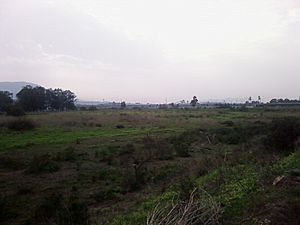Mainake (Greek settlement) facts for kids
Mainake (also called Menace) was an ancient Greek city located in the southeast of Spain. Historians like Strabo and Pausanias of Damascus wrote about it. Pausanias even said it was a colony, or new settlement, started by people from the Greek city of Massalia.
Today, some experts believe Mainake was located where the modern city of Málaga is. The very first settlement in this area, around the late 700s BC, was actually built by the Phoenicians. They were skilled sailors from Tyre, Lebanon. Their settlement was on a small island in the mouth of the Guadalhorce River at a place called Cerro del Villar. The coastline has changed a lot since then, as the river has filled in the old estuary.
Contents
Greeks Arrive in Iberia
The Phoenicians had many settlements along the coast east of Gibraltar. But the Greeks also wanted to trade in Iberia (ancient Spain). They set up their own trading posts along the northeastern coast first. Then, they moved into areas where the Phoenicians were already trading.
The Tartessians, a local people, might have encouraged the Greeks. They probably wanted to break the Phoenician control over trade. The historian Herodotus wrote that around 630 BC, people from the Greek city of Phocaea became friends with King Arganthonios of Tartessos. He even gave them money to build walls around their city! Later, these Greeks founded Mainake on the Málaga coast.
Where Was Mainake?
For a long time, people have debated exactly where Mainake was. New archaeological digs have brought up new ideas. An old merchants' guide called the Massaliote Periplus describes Mainake as being on an island with a good harbor, under the control of the Tartessians. It also says the city was near a river of the same name and surrounded by salty lagoons.
Studies of the land and environment show that the Phoenician settlement at Cerro del Villar was indeed on an ancient island. This island is now a raised area in a flat, river-filled plain west of Málaga.
The Periplus and Malaca
The Periplus was like a map and guide for traders. It described sea routes used by Phoenician and Tartessian merchants. It might be as old as the 500s BC. This guide is one of the oldest texts to suggest that Malaca (modern Málaga) was the same as Mainake.
It describes a sea journey around 525 BC from Massalia (Marseille) along the western Mediterranean coast. A later Roman writer, Rufus Festus Avienius, copied parts of this guide in the 300s AD. He wrote that Mainake was near an island dedicated to a goddess called Noctiluca. This island had a marsh and a safe harbor.
The Mystery of Mainake's Location
The Greek city of Mainake likely existed for at least 200 years. Many old documents mention it and its busy trade. Some ancient historians, like Strabo, thought Mainake was east of Malaka. However, recent archaeological discoveries suggest that the Phoenician settlement at Cerro del Villar, which dates back to the 700s BC, might actually be the site of the Greek colony. This site is less than 5 kilometers (about 3 miles) west of where Malaka originally stood.
According to old writings, Mainake was slowly abandoned after the Battle of Alalia. This battle led to the decline of Greek trade from Phocaea. Because of this, the people living there might have moved to the Phoenician city of Malaka.
Strabo's View
The Greek historian and geographer Strabo (who lived from 64 BC to 24 AD) wrote in his book Geographica that some people in his time thought Mainake was the same as Malaca. But he disagreed. He pointed out that the ruins of Mainake could still be seen near Malaca. He said these ruins showed the organized, planned layout typical of Greek cities, while Malaka had a more jumbled, unplanned look like a Semitic (Phoenician) city.
Strabo mentioned that Malaca was a market for people from the opposite coast of Africa. It also had large factories for salting fish. He said Mainake was further from Calpe (an ancient name for Gibraltar) and was in ruins, but still showed signs of being a Greek city. Malaca, he said, was closer and had a Phoenician design.
We don't know the exact layout of ancient Malaka. But it was built on a hill at the base of Mount Gibralfaro. This suggests it was a more crowded and less organized city than nearby Cerro del Villar (Mainake). Traces of old landing spots and a port at Cerro del Villar match the descriptions in the Periplus. The ruins Strabo saw in the 1st century BC could only belong to a place that was already empty by Roman times, which was true for Cerro del Villar but not for Malaka. The Phoenician city at Cerro del Villar was in ruins by the early 500s BC, when the Phocaean Greeks seem to have settled there.
Today, some maps suggest Mainake's likely spot is the hill of Cerro del Peñón, near the mouth of the Vélez River, south of Vélez-Málaga.
Images for kids
See also
 In Spanish: Mainake para niños
In Spanish: Mainake para niños



